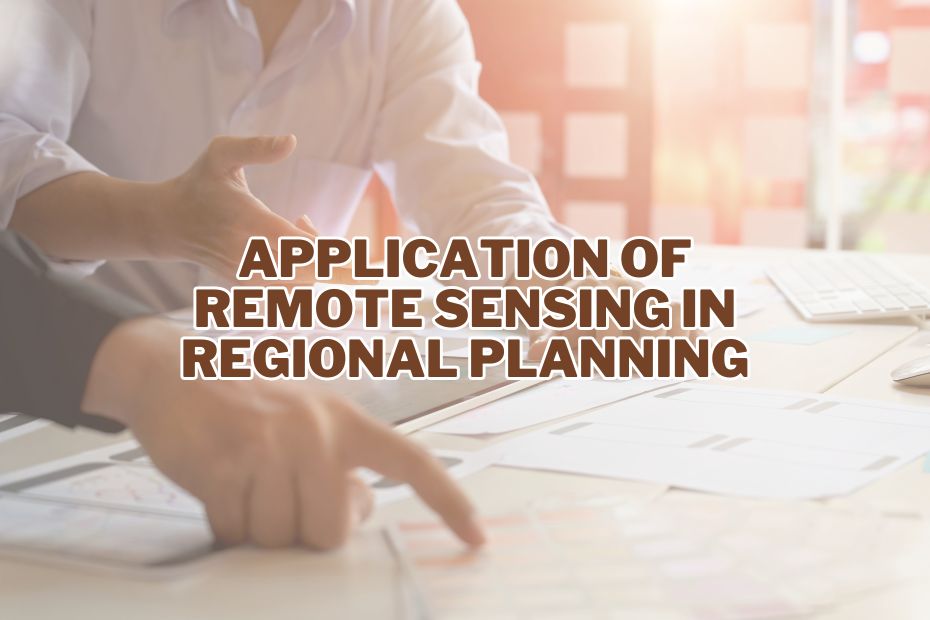In the realm of regional planning, the integration of remote sensing technologies has ushered in a new era of precision and efficiency. Remote sensing, the art of collecting data from a distance using various sensors and platforms, has found applications in numerous aspects of regional planning. From monitoring land use changes to assessing environmental impacts, here are some compelling application of remote sensing in regional planning.
Remote sensing is a pivotal tool in regional planning, offering precise data for land use mapping, environmental monitoring, disaster management, urban planning, agriculture, transportation, and more.
Application of Remote Sensing In Regional Planning
Regional planning is a complex and critical endeavor that involves the development and management of land, resources, and infrastructure within a specific geographic area. To make informed decisions in regional planning, it is essential to have accurate and up-to-date information about the environment, land use, and various other factors. This is where remote sensing technology plays a pivotal role. Let’s delve into some applications:
1. Land Use and Land Cover Mapping
Understanding the current land use and land cover is fundamental to regional planning. Remote sensing enables us to create detailed maps that categorize and quantify different types of land cover, such as forests, urban areas, agricultural fields, and water bodies. These maps serve as the foundation for land use planning, helping authorities make informed decisions about zoning, conservation, and development.
2. Environmental Monitoring
Remote sensing is a powerful tool for monitoring environmental changes. By analyzing satellite imagery and sensor data, scientists and planners can track variations in vegetation, water quality, and air pollution levels. This information is crucial for assessing the impact of human activities and climate change on the environment, guiding regional policies aimed at sustainability and conservation.
3. Disaster Management
Natural disasters like hurricanes, wildfires, and floods can have devastating effects on regions. Remote sensing provides real-time data and imagery that help emergency responders and planners assess the extent of damage, plan evacuation routes, and allocate resources efficiently. Additionally, it aids in creating hazard maps, enhancing preparedness for future disasters.
4. Urban Planning
Managing urban growth is a significant challenge in regional planning. Remote sensing offers a comprehensive view of urban development, enabling city planners to analyze population density, infrastructure needs, and traffic patterns. It plays a pivotal role in designing sustainable cities and optimizing resource allocation.
5. Agriculture and Crop Management
Agriculture is the backbone of many regions, and efficient crop management is vital for food security. Remote sensing provides farmers and agricultural planners with essential information about crop health, soil moisture, and pest infestations. By optimizing agricultural practices, regions can increase crop yields and reduce environmental impact.
6. Transportation Planning
Efficient transportation networks are essential for regional development. Remote sensing aids in designing transportation systems by providing data on traffic flow, road conditions, and infrastructure development. This information is pivotal for reducing congestion, improving connectivity, and enhancing overall mobility.
7. Water Resource Management
Water scarcity is a pressing issue in many regions. Remote sensing facilitates the monitoring of water resources, including lakes, rivers, and groundwater. It helps in tracking changes in water levels, identifying pollution sources, and managing water distribution, contributing to sustainable water resource management.
8. Forest and Wildlife Conservation
Preserving forests and wildlife habitats is essential for biodiversity and ecosystem health. Remote sensing provides valuable data for monitoring deforestation, illegal logging, and wildlife populations. This information guides conservation efforts, enabling regions to protect their natural heritage.
9. Infrastructure Development
Infrastructure forms the backbone of regional development. Remote sensing aids in planning and monitoring infrastructure projects such as roads, bridges, and utilities. By ensuring efficient construction and maintenance, regions can enhance their connectivity and quality of life.
10. Coastal Zone Management
Coastal regions are vulnerable to natural disasters and sea-level rise. Remote sensing assists in monitoring coastal erosion, sea-level changes, and the health of coastal ecosystems. This information is crucial for planning and implementing strategies to protect coastal communities and ecosystems.
11. Archaeological Surveys
Preserving cultural heritage is integral to regional planning. Remote sensing aids in archaeological surveys by detecting buried structures and ancient landscapes. This technology helps uncover historical sites and artifacts, contributing to the preservation of a region’s cultural identity.
Conclusion:
In conclusion, remote sensing is a versatile and indispensable tool in regional planning. It empowers planners, policymakers, and scientists with accurate and timely data across various domains, from environmental monitoring to disaster management. By harnessing the power of remote sensing, regions can make informed decisions that shape a sustainable and prosperous future.
FAQs: Application of Remote Sensing In Regional Planning
How does remote sensing benefit regional planning?
Remote sensing provides valuable data on land use, environmental conditions, infrastructure, and more. This data is crucial for making informed decisions related to urban development, resource management, and disaster response in regional planning.
What types of data can be collected through remote sensing for regional planning?
Remote sensing can collect data such as land cover, land use, elevation, temperature, vegetation health, and pollution levels. These data sets are essential for understanding the characteristics and dynamics of a region.
What technologies are commonly used in remote sensing for regional planning?
Common technologies used include satellites, drones, LiDAR (Light Detection and Ranging), and various sensors. These technologies capture data in different wavelengths, allowing for a comprehensive view of a region.
Are there any limitations to remote sensing in regional planning?
Remote sensing has limitations such as cloud cover interference, limited resolution in some sensors, and the need for specialized training to interpret data. Additionally, it may not provide information on social and economic factors, which are also important in regional planning.
